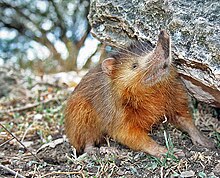Solenodon
Solenodons (meaning "slotted-tooth") are venomous, nocturnal mammals in the family Solenodontidae.[3][1][2] They are burrowing insectivores.
| Solenodon[3] Temporal range:
| |
|---|---|

| |
| Hispaniolan solenodon | |
| Scientific classification | |
| Domain: | Eukaryota |
| Kingdom: | Animalia |
| Phylum: | Chordata |
| Class: | Mammalia |
| Order: | Eulipotyphla |
| Family: | Solenodontidae Gill, 1872 |
| Genus: | Solenodon Brandt, 1833 |
| Type species | |
| Solenodon paradoxus Brandt, 1833
| |
| Species | |
|
† Solenodon arredondoi | |
There is only one genus, Solenodon, They keep some primitive mammal characteristics. Their species resemble closely those which lived near the end of the age of the dinosaurs.
The two living solenodon species are the Cuban Solenodon (Solenodon cubanus), and the Haitian or Hispaniolan solenodon (Solenodon paradoxus). The Hispaniolan solenodon lives in many habitats on the island of Hispaniola from lowland dry forest to highland pine forest. Two other described species went extinct during the Quaternary.[3] Oligocene North American genera, such as Apternodus, have been suggested as relatives of Solenodon.[1]
References
change- ↑ 1.0 1.1 1.2 Whidden H.P. & Asher R.J. 2001. The origin of the Greater Antillean insectivorans. in Woods C.A. & Sergile F.E. Biogeography of the West Indies: patterns and perspectives. Boca Raton: CRC Press, pp. 237–252. ISBN 0-8493-2001-1 [1]
- ↑ 2.0 2.1 Savage R.J.G. & Long M.R. 1986. Mammal evolution: an illustrated guide. New York: Facts on File, p51. ISBN 0-8160-1194-X
- ↑ 3.0 3.1 3.2 Hutterer R. 2005. Order Soricomorpha. In Wilson D.E. & Reeder D.M. Mammal species of the world. 3rd ed, Johns Hopkins University Press. pp. 222–223. ISBN 978-0-8018-8221-0 [2]